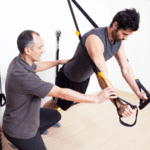Urge incontinence is when one feels that they have to use the bathroom and can’t wait or can’t wait very long to get to a bathroom. Common triggers can be hearing running water, entering the home or facility where there is a bathroom, or waking up either in the night or in the morning.

How does urge incontinence develop? Typically this occurs over time due to a change in urinary habits. If one preventatively uses the restroom frequently because they are worried about or think they will have leakage this send signals to the brain that one has to use the restroom even if the bladder is not very full. Over time, the brain will tell bladder that one has to urinate at the first urge signal or before.
Another way this can develop is through bladder irritants. Certain foods and liquids such as citrus, chocolate, acidic foods, and caffeine can irritate the bladder and tell the brain one needs to use to the restroom right away. Although this may seem counterproductive, making sure one is drinking plenty of water will help. Drinking water will dilute the bladder irritants and help flush them from the bladder lining that is sending signals to the brain.
Normal bladder habits allow one to feel urge when the bladder is about a quarter of the way full and then another sense of urge when the bladder is half full. When the bladder is about half full or more, urge will be stronger and this is typically when one will decide to use the restroom. Normal frequency of urination is every 2-4 hours and 6-8 times a day depending on fluid intake. If one is urinating for at least 8 seconds then the bladder is about half full. If one is frequently urinating or urinating preventatively every hour, half hour or even sooner in some cases, this is not normal.
How can physical therapy help? Your pelvic floor physical therapist can check the pelvic floor muscles to ensure they are contracting and relaxing appropriately for proper sphincter control. In addition, one’s physical therapist can go over food intake, drink intake, and bladder habits to determine if one needs to restrict certain foods or fluids and to determine if the bladder habits are normal. With this, your physical therapist will go over strategies and exercises that can reduce urge and in many cases allow you to resume a normal life style.



